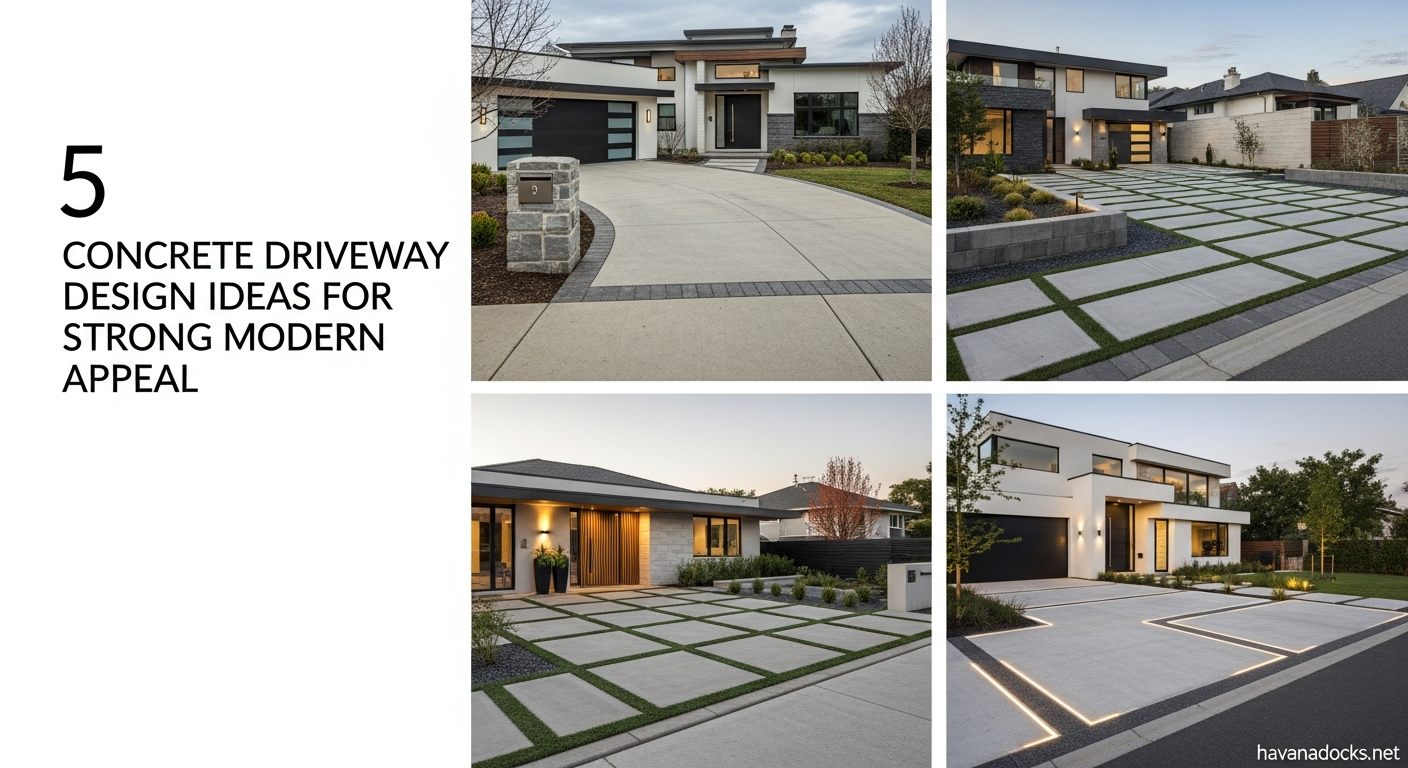5 Concrete Driveway Design Ideas for Strong Modern Appeal
5 Concrete Driveway Design – Modern design emphasizes clean lines, simplicity, and functionality. When it comes to concrete driveway design, these principles translate into driveways that are sleek, durable, and visually appealing. Let’s dive into five design ideas that embody these characteristics.

Exposed Aggregate Concrete Driveways
Exposed aggregate concrete driveways offer a unique textural element that can significantly enhance your home’s modern appeal. This concrete driveway design involves removing the top layer of cement paste to reveal the underlying aggregate, such as pebbles, stones, or shells.
Benefits of Exposed Aggregate
- Enhanced Aesthetics: The exposed aggregate provides a natural, textured surface that adds visual interest and depth. This contrasts beautifully with the smooth surfaces often found in modern architecture. The variety of aggregate options—from rounded river stones to crushed granite—allows for customization to match your landscape and home style.
- Improved Traction: The textured surface of exposed aggregate increases traction, making it a safer option than some smoother concrete finishes, especially in wet or icy conditions. This improved grip is a valuable safety feature.
- Durability and Longevity: The revealing process creates a durable surface that is resistant to wear and tear. The aggregate is inherently strong, and the method itself creates a robust surface layer resistant to the elements.
Design Considerations for Exposed Aggregate
- Aggregate Selection: Choose aggregates that complement your home’s color scheme and architectural style. Consider the size, shape, and color of the stones or pebbles. Darker aggregates paired with light-colored concrete can create a dramatic contrast, while softer, earth-toned aggregates often provide a more natural, subtle look.
- Color Options: The concrete mix itself can be tinted to create a variety of color palettes. Experiment with different shades of gray, beige, or even bolder hues to achieve the desired effect. Careful consideration of the color interaction between the concrete and the aggregate is vital.
- Sealing: Applying a high-quality sealant protects the exposed aggregate from staining and damage. Sealants also enhance the color and vibrancy of the aggregate, providing a longer-lasting finish. Regular maintenance of the sealant is essential for sustained appearance and protection.
Stamped Concrete Driveways: Patterns and Textures
Stamped concrete offers incredible versatility in concrete driveway design, allowing you to mimic the look of more expensive materials like brick, pavers, or natural stone, all while enjoying the durability and cost-effectiveness of concrete. Numerous patterns and textures can be created to suit different architectural styles, making it one of the most customizable driveway options available today.
One of the biggest advantages of stamped concrete is its ability to replicate premium materials without the high installation or long-term maintenance costs. Homeowners can choose from patterns such as herringbone brick, cobblestone, slate, flagstone, wood plank, or even intricate geometric designs. These patterns can be combined with color staining techniques to produce realistic shading, depth, and surface variations that closely resemble natural materials. This makes stamped concrete a perfect option for adding sophistication and visual interest to your outdoor space while staying within budget.
Beyond aesthetics, stamped concrete driveways are known for their structural strength and longevity. When properly installed and sealed, they can withstand heavy vehicles, harsh weather conditions, and regular wear without cracking or fading easily. Sealants also protect the surface from stains, moisture penetration, and UV damage, ensuring the driveway maintains its vibrant look for many years. This makes it an excellent long-term investment for homeowners who want both beauty and resilience.
Another benefit of stamped concrete is the flexibility it offers during installation. Unlike individually laid pavers or stones, stamped concrete is poured as a single slab, allowing for faster installation and fewer alignment issues. This also reduces the potential for weeds or grass to grow between joints, giving the driveway a cleaner and more uniform appearance. Additionally, the seamless nature of the surface makes snow removal and cleaning easier compared to textured paver driveways.
Stamped concrete can also be customized to complement surrounding landscaping and exterior home design. For modern homes, patterns with clean lines and subtle texture—such as large slate tiles or smooth geometric grids—create a sleek, contemporary look. For more traditional homes, rustic stone or classic brick patterns bring a warm, timeless feel. You can even choose border accents in contrasting colors or textures to frame the driveway and enhance visual depth.
Color options are equally diverse. Integral color, acid staining, and surface hardeners can be used to create rich, multi-dimensional tones that mimic natural materials. Whether you prefer earthy browns, warm terracotta, cool grays, or deep charcoal tones, stamped concrete can be tailored to match your design preferences and overall exterior palette.
In addition to visual benefits, stamped concrete supports functional enhancements such as slip-resistant coatings for safety during wet seasons and decorative saw-cut joints to control cracking and improve design flow. These features make stamped concrete not only beautiful but also practical for everyday use.
Overall, stamped concrete combines beauty, durability, and affordability into a single solution, making it one of the most popular choices for homeowners seeking a high-end look without the high-end cost. With endless design possibilities, stamped concrete allows you to create a driveway that truly stands out while offering long-lasting performance and minimal maintenance.
Popular Stamped Concrete Patterns
- Brick Patterns: Create a classic and timeless look with brick patterns. These patterns offer a traditional aesthetic that works well with various architectural styles. Different brick layouts, such as running bond, herringbone, or basket weave, can further customize the look.
- Stone Patterns: Replicate the natural beauty of stone with stamped stone patterns. These patterns can mimic various stone types, including flagstone, slate, and cobblestone. The irregular shapes and textures of stone create a more rustic and organic feel.
- Wood Plank Patterns: Achieve the warm and inviting look of wood planks with stamped concrete. This unique pattern can add a touch of rustic charm to your driveway while maintaining the durability of concrete. Wood plank patterns are particularly suited to homes with a farmhouse or craftsman aesthetic.
Achieving a Modern Look with Stamped Concrete
- Geometric Patterns: Use geometric patterns like squares, rectangles, and triangles for a sleek, modern aesthetic. These patterns provide a clean and structured look that complements contemporary architecture. Consider using contrasting colors or finishes to highlight the geometric design.
- Large-Scale Textures: Opt for large-scale textures with minimal detail for a minimalist, modern appearance. Simple patterns like brushed concrete or light broom finishes can create a subtle yet sophisticated look. The simplicity of these textures allows the concrete itself to take center stage.
- Color Considerations: Choose neutral colors like gray, charcoal, or concrete white to maintain a contemporary feel. Avoid overly ornate or rustic patterns that may clash with the modern aesthetic. Monochromatic color schemes are often the most effective in achieving a modern look.
Adding Color to Stamped Concrete
- Integral Color: Integral color is added to the concrete mix before it’s poured, providing a uniform color throughout the slab. This method offers a consistent and long-lasting color that won’t fade or wear away easily.
- Color Hardener: Color hardener is applied to the surface of the concrete after it’s poured but before it’s stamped. This method creates a more vibrant and durable color that resists abrasion and wear. Color hardeners also add a layer of strength to the concrete surface.
- Stains and Sealers: Stains and sealers can be applied after the concrete has cured to enhance the color or add a protective layer. These products offer flexibility in color selection and can be used to create unique effects. However, they may require more frequent maintenance than integral color or color hardener.

Colored Concrete Driveways: Subtlety and Boldness
Colored concrete offers a wide range of possibilities for concrete driveway design. From subtle earth tones to bold, eye-catching hues, colored concrete can transform your driveway into a personalized statement.
Color Options for Modern Driveways
- Grays and Charcoals: The gray scale provides a sophisticated and versatile palette for modern driveways. From light, airy grays to deep, dramatic charcoals, these colors complement a variety of architectural styles. Grays and charcoals offer a timeless elegance and provide a neutral backdrop for landscaping and other exterior features.
- Beiges and Creams: For a warmer and more inviting look, consider beiges and creams. These colors create a soft and natural aesthetic that blends seamlessly with the surrounding environment. They are particularly well-suited for homes with warmer color schemes or more traditional architectural styles.
- Earth Tones: Earth tones like browns, tans, and terracotta can add a touch of rustic charm to your modern driveway. These colors create a natural and organic feel, particularly when paired with exposed aggregate or stamped concrete patterns.
- Accent Colors: While bold colors might not be suitable for the entire driveway, they can be used as accent colors. Incorporate a colored border, a decorative design, or colored concrete pavers to add visual interest and personality to your driveway. Consider using hues that complement your home’s exterior or landscaping.
Techniques for Coloring Concrete
- Integral Coloring: As mentioned above, integral coloring involves adding pigment to the concrete mix before it’s poured. This method provides a consistent color throughout the concrete slab and is ideal for achieving uniform color across large areas.
- Surface Coloring: Surface coloring techniques, such as stains and dyes, are applied to the surface of the concrete after it has cured. These methods allow for greater control over the color and can be used to create unique effects, like gradients and multi-toned finishes.
- Dry-Shake Color Hardener: Dry-shake color hardener is a powder that is sprinkled onto the surface of the concrete during the finishing process. This method provides a durable and vibrant color that resists abrasion and wear. It is generally favored for high-traffic areas.
Maintaining Colored Concrete
- Sealing: Sealing the concrete protects the color from fading and staining. A high-quality sealant provides a barrier against moisture, UV rays, and other environmental factors that can damage the color.
- Cleaning: Regular cleaning with mild soap and water helps to remove dirt, debris, and stains that can dull the color. Avoid using harsh chemicals or abrasive cleaners that could damage the concrete surface.
- Re-Sealing: Over time, the sealant will wear away, necessitating re-application. The frequency of re-sealing depends on the climate and the amount of traffic your driveway receives.
Permeable Concrete Driveways: Eco-Friendly Modernity
Permeable concrete is an increasingly popular choice for concrete driveway design, especially for homeowners seeking an eco-friendly and modern solution. Unlike traditional concrete, permeable concrete allows water to drain through its surface and into the underlying soil.
How Permeable Concrete Works
Permeable concrete is made with a mix of coarse aggregate, cement, and water. It lacks the fine aggregates (sand) typically found in conventional concrete, creating interconnected voids that allow water to pass through. This porous structure enables rainwater to infiltrate the ground, reducing runoff and replenishing groundwater supplies.
Environmental Benefits of Permeable Concrete
- Reduced Runoff: By allowing rainwater to infiltrate the ground, permeable concrete reduces runoff. This prevents erosion, minimizes flooding, and reduces the strain on stormwater management systems.
- Groundwater Recharge: Permeable concrete helps to replenish groundwater supplies. This is particularly important in areas with limited water resources or where groundwater levels are declining.
- Pollution Reduction: As rainwater filters through the permeable concrete and underlying soil, pollutants are naturally filtered out. This helps to improve the quality of stormwater runoff and protect local waterways.
- Reduced Heat Island Effect: Permeable concrete has a lower thermal mass than traditional concrete. Thus, it heats up less in the sun. Consequently, it reduces the urban heat island effect.
Design Considerations for Permeable Concrete
- Sub-Base Preparation: Proper sub-base preparation is crucial for the performance of permeable concrete. The sub-base should be well-draining and compacted to ensure proper water infiltration.
- Slope and Drainage: The driveway should be sloped slightly to direct water towards the permeable concrete surface. Ensure that the surrounding area is properly graded to prevent water from pooling on the surface.
- Maintenance: Permeable concrete requires regular maintenance. Vacuuming or pressure washing the surface periodically helps to remove debris and prevent clogging of the pores.
- Climate Considerations: Permeable concrete may not be suitable for all climates. In areas with heavy snowfall or frequent freeze-thaw cycles, the porous structure can become damaged. You need to check your local building codes related to permeable pavements as well.
Concrete Paver Driveways: Individual Elegance and Durability
Concrete pavers offer a modular and elegant solution for concrete driveway design. Individual pavers that are laid in various patterns create driveways. Pavers provide a visually appealing and durable surface that complements modern architecture.
Types of Concrete Pavers
- Rectangular Pavers: Rectangular pavers are a classic and versatile choice. They can be laid in a variety of patterns, including running bond, herringbone, and basket weave.
- Square Pavers: Square pavers offer a clean and modern look. They can be laid in a grid pattern or offset to create visual interest.
- Interlocking Pavers: Interlocking pavers are designed to fit together tightly. That creates a strong and stable surface. These pavers are available in a variety of shapes and sizes and are excellent for high-traffic areas.
- Permeable Pavers: Permeable pavers are designed with gaps between them to allow water to drain through the surface. These are an eco-friendly alternative to traditional concrete pavers.
Design Options with Concrete Pavers
- Patterns and Layouts: Experiment with different patterns and layouts to create a unique and visually appealing driveway. Consider using contrasting colors or paver sizes to highlight the pattern. Common patterns include herringbone, running bond, basketweave, and circular designs.
- Borders and Edges: Use pavers of a different color or texture to create a defined border around the driveway. This adds visual interest and helps to contain the pavers.
- Color Combinations: Mix and match different paver colors to create a custom design. Consider the color of your home and surrounding landscape to choose colors that complement the overall aesthetic.
- Inlays and Accents: Incorporate inlays or accents into the paver design to add a personal touch. Consider using decorative stones, mosaic tiles, or metal inserts.

Installation and Maintenance of Concrete Pavers
- Base Preparation: Proper base preparation is essential for the longevity of a paver driveway. The base should be compacted and leveled to ensure a stable foundation.
- Laying the Pavers: Lay the pavers according to your chosen pattern. Use a rubber mallet to gently tap the pavers into place.
- Filling the Joints: Fill the joints between the pavers with sand or gravel. This helps to lock the pavers together and prevents weed growth.
- Sealing: Sealing the pavers protects them from staining and fading. A high-quality sealant repels water and oil. Thus, that helps keep the pavers looking their best.
Benefits of Choosing Concrete Pavers
- Durability: Concrete pavers are incredibly durable and can withstand heavy traffic and harsh weather conditions.
- Aesthetics: Pavers offer a wide range of design options. They enhance the curb appeal of your home.
- Easy Maintenance: Pavers are relatively easy to maintain. Regular cleaning and occasional sealing are all that’s typically required.
- Repairability: If a paver becomes damaged, it can be easily replaced without affecting the surrounding area.
- Increased Home Value: A well-designed paver driveway can increase the value of your home.
Conclusion
Choosing the right concrete driveway design is a significant decision that can greatly impact the aesthetic and value of your property. Whether you opt for the textured beauty of exposed aggregate, the versatility of stamped concrete, the personalized touch of colored concrete, the eco-friendliness of permeable concrete, or the modular elegance of concrete pavers, each option offers a unique blend of style and functionality. Take the time to carefully consider your home’s architecture, your personal preferences, and your budget to select the concrete driveway design that perfectly complements your modern aesthetic. Ultimately, investing in a well-designed driveway is an investment in your home’s long-term value and appeal.





